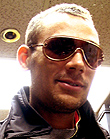|
|
This topic comprises 2 pages: 1 2
|
|
Author
|
Topic: Threading up a silent film without a soundtrack for reference
|
|
|
|
|
|
|
Robert Harrison
Expert Film Handler
Posts: 239
From: Harwood Heights, Illinois, USA
Registered: Jun 2005
|
 posted 04-08-2011 09:48 PM
posted 04-08-2011 09:48 PM




Well, upon closer inspection, I noticed that, while the prints don't have analog optical soundtracks, they do have Dolby Digital tracks between the sprocket holes. I suppose someone was concerned with not cropping the original image, while still maintaining musical accompaniment for screenings where a live organist won't be present. Assuming, of course, one has Dolby Digital, which we don't.
Thanx for your replies.
| IP: Logged
|
|
|
|
|
|
|
|
|
|
|
|
|
|
|
|
|
|
Richard P. May
Expert Film Handler
Posts: 243
From: Los Angeles, CA
Registered: Jan 2006
|
 posted 04-09-2011 10:27 AM
posted 04-09-2011 10:27 AM




Full aperture negatives printed down to Academy aperture are generally called either "reduced aperture" or "FA/RA" (Full aperture to reduced aperture).
When done properly, there is nothing to get concerned about. It just allows the venue which does not have the lenses and aperture plates for the full (silent) aperture to present the film without any cropping of the image and there is no reason the audience would even know the difference.
In addition, those films produced in the transition period, where there is an optical track containing music and effects, but no dialog, can also be shown without the track chopping off the left 10% of the picture.
Many of the Warner Bros. features made during the Vitaphone era have this missing left side, and it is very obvious, especially during the titles. They were originally run with disc sound reproduction, and the picture retained the silent format. Once optical sound took over, these same negatives were used for composite prints, but leaving the full aperture negative obscured by the optical track on the left side.
Why make a print with an optical track containing music, but no dialog, when obviously a theater that had sound equipment would likely want the dialog? It was the foreign market. A movie could be printed using the silent negative, and foreign language intertitles exchanged for the original English ones.
Since the track negative was separate from the picture negative for printing, there would not be any interruption in the recorded music.
| IP: Logged
|
|
|
|
Stephen Furley
Film God

Posts: 3059
From: Coulsdon, Croydon, England
Registered: May 2002
|
 posted 04-10-2011 04:39 AM
posted 04-10-2011 04:39 AM




quote: Richard P. May
Full aperture negatives printed down to Academy aperture are generally called either "reduced aperture" or "FA/RA" (Full aperture to reduced aperture).
When done properly, there is nothing to get concerned about. It just allows the venue which does not have the lenses and aperture plates for the full (silent) aperture to present the film without any cropping of the image and there is no reason the audience would even know the difference.
I have mixed feelings about this; the loss in picture area isn't great, but it's not negligible either. I can't remember the exact frame sizes off-hand, but I think it's something like 16% loss. Theatres which show silent film once are likely to do so again, so obtaining plates and lenses isn't a major issue. It's a bit more difficult for places with automatic aperture changers which only support 1.85 and Scope, but these would have the same problem with running an Academy print. These problems are not that difficult to get round.
Reducing to Academy does avoid the problem of re-centering the optical axis, which is often more difficult to do, unless the theatre has 70 mm machines.
I have no mixed feelings about the more extreme reduced frame formats, such as Academy within 1.85, or the anamorphic 'Academy' within Scope which was used for the re-release of something, was it 'Gone with the Wind'? I'm opposed to these for the same reason as Scott.
| IP: Logged
|
|
|
|
All times are Central (GMT -6:00)
|
This topic comprises 2 pages: 1 2
|
Powered by Infopop Corporation
UBB.classicTM
6.3.1.2
The Film-Tech Forums are designed for various members related to the cinema industry to express their opinions, viewpoints and testimonials on various products, services and events based upon speculation, personal knowledge and factual information through use, therefore all views represented here allow no liability upon the publishers of this web site and the owners of said views assume no liability for any ill will resulting from these postings. The posts made here are for educational as well as entertainment purposes and as such anyone viewing this portion of the website must accept these views as statements of the author of that opinion
and agrees to release the authors from any and all liability.
|

 Home
Home
 Products
Products
 Store
Store
 Forum
Forum
 Warehouse
Warehouse
 Contact Us
Contact Us




 Printer-friendly view of this topic
Printer-friendly view of this topic

















